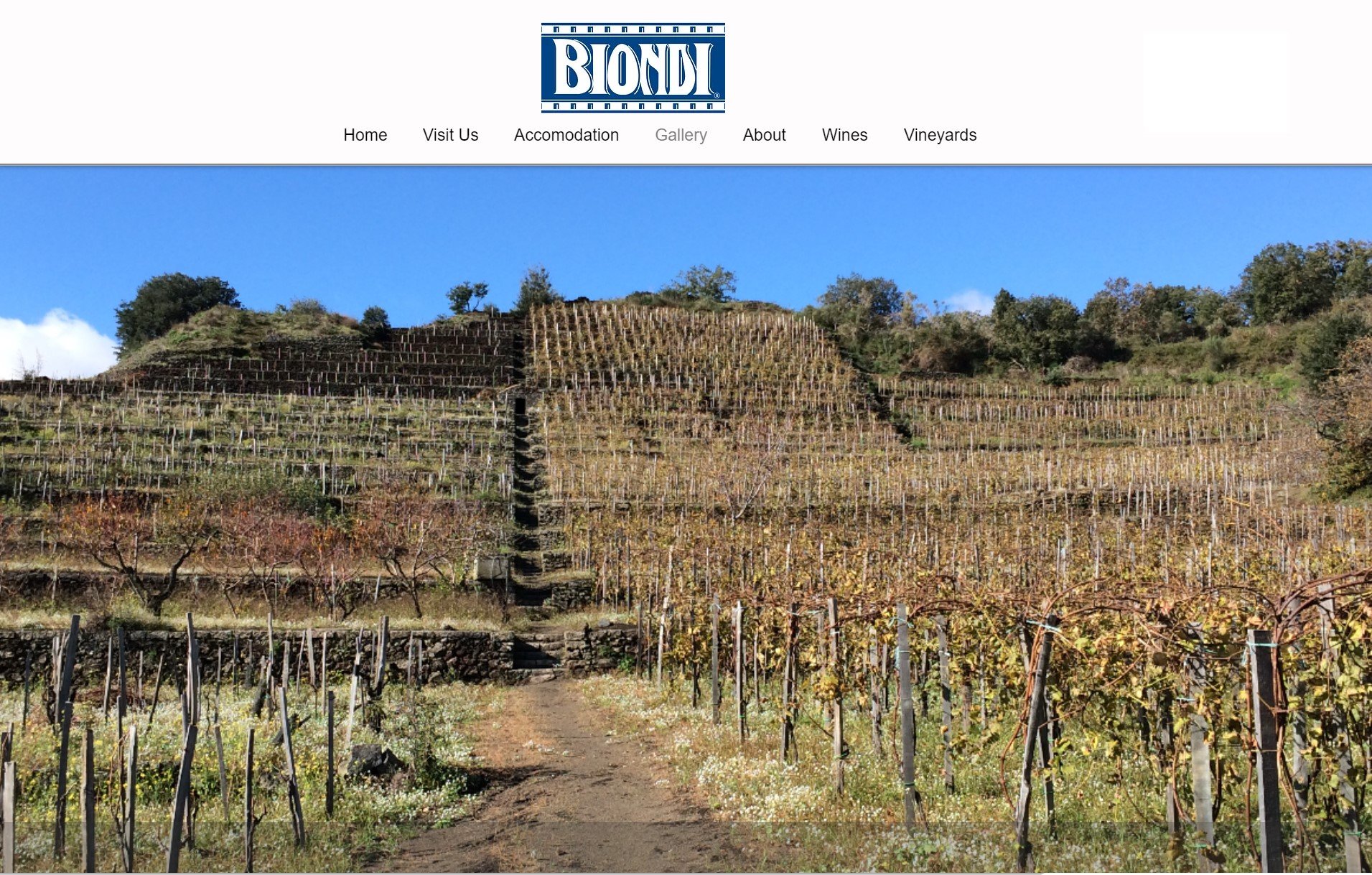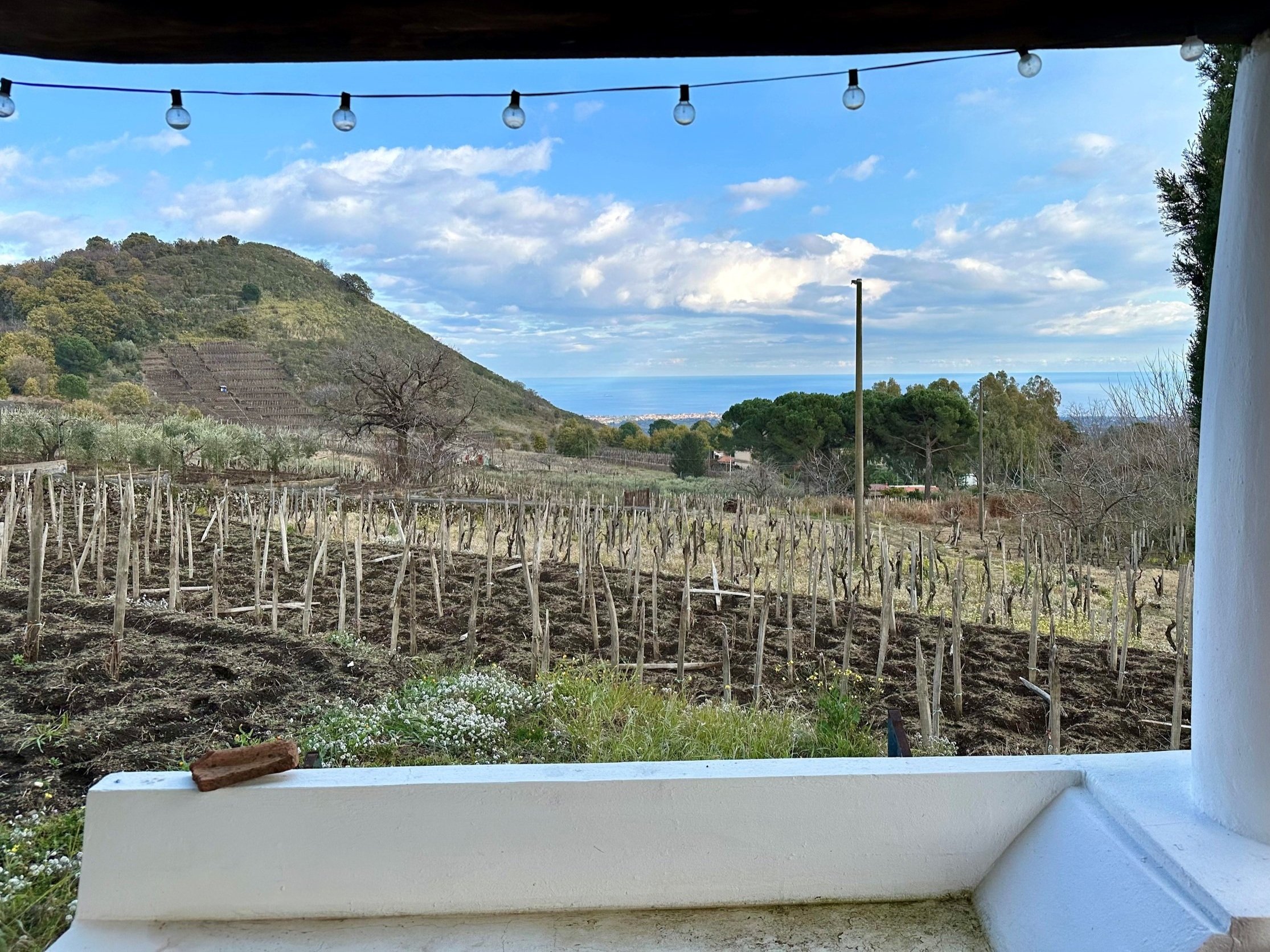Ciro Biondi
Sicily's wine heritage runs deep. It is one of the many reasons why we can return year after year - the discoveries are endless. Every vintner you meet has their own unique story, steeped in history, family and tradition. Sure they all have wine in common, but their approach is uniquely theirs.
Many people across Sicily will claim to be the “Il Primo” (first), “Il piu vecchio (oldest), or “L’originale “ (you can understand that one). While many of them have histories and roots to the wine they make, few of them can make the claim that Ciro Biondi and the entire Biondi family can - 15 generations of wine making that started on their slice of Mount Enta in the 1600s.
Greek carving embedded in the wall of the Cisterna Fuori tastng patio.
The Biondis are located on the southern slopes of Mount Etna, in a contrada (recognized region) called Trecastagni. This area is steeped in geological and historical significance. A portion of their mountain was formed around 2,000 years ago, estimated to be in 25 BCE, during one of Etna’s powerful eruptions, a fact confirmed through detailed geological surveys. In the aftermath, a blanket of volcanic ash a meter deep, was left behind, enriching the soil with vital minerals. While their single varietal San Nicolo grows in a 12,000-year-old crater just across from the family home, their wine cellar dates back to the 1600s and has remained in the family’s possession for generations.
The history of the Biondi estate isn’t just embedded in the soil—it’s also etched in stone. Their outdoor tasting room, features a curious relic of a Greek statue embedded in the wall that hints at the long and varied history of this land. The statue itself offers a glimpse into the lighter side of antiquity… let’s just say it was hilarious to see the Greeks had the same sense of humor as teenage boys all those years ago…
Driving into Biondi winery along their natural road forgoes the grand entrances of the wineries on Etna's northern slopes.
Getting to Ciro’s is different than the rest of Mt. Etna - fewer visitors explore the southern slopes, instead heading to the tightly packed northern slopes, where wineries are all the eye sees. Out of Catania, in fact I get to avoid the E45 autostrada that most tourists take up to Piedemonte Etneo, and instead head out for the Strada Pronvinciale 8iii that takes you through the much smaller and neighborly town of Trecastagni. After a quick road side cafe shop, I realize the winery is so non-descript that I drive right by the entrance. After wandering through the roads that snake up the hill for a while, a few WhatsApp messages to Ciro, I finally find the gate and Ciro with an Israeli tourist couple waiting to let me into his volcanic oasis.
Driving in, I’m hit by how agrarian this winery feels compared to the larger, commercial winery on Etna’s north slope. I’m greeted at my car by two mastiffs - Elsa and Spotty. They become our companions for the day - romping through the vineyards, sitting at our feet for dropped food scraps during the tasting. We start to make our way up to the vineyard road towards their Contrada Ronzini vineyard, and ancient outdoor tasting patio.
The vineyards are 18KM from the ocean, meaning they are still hit with salty ocean breezes throughout the growing and harvest season - this comes through in their salinity. This combination of ocean air and volcanic soils is unique to Etna producers with just the right aspect.
Ciro’s grandfather, Cirino, won awards with their wines in Paris and Lyon from 1912 - 1940, but this was when the Biondi family abandoned the works due to the untimely death of Salvatore Biondi (Ciro’s great uncle) who had been the driving force of the winery before WWII. Ciro’s father did not keep the work going and it wasn’t until 1999 when Ciro took the reigns and brought the winery back to it’s glory of producing high quality single vineyard and cuvee blends.
Ciro kept the tradition and unique process that made his family’s wines prized two generations prior. The vineyard uses chestnut staves to support the vines, as they would have for centuries because it is the indigenous and plentiful wood available. Until recently, they also used chestnut barrels to age all of their wines. They have since progressed to more modern aging vessels using french oak and stainless steel where appropriate.
Today, Biondi’s vines covers 6 hectares across three vineyards in two contradas - San Nicolo, Ronzini, and Cisterna Fuori. They produce ~21,000 bottles annually across 5 labels - Single vineyard bottles are Pianta (Conada Ronzini), San Nicolo (Contrada San Nicolo), Cisterna Fuori (Contrada Ronzini), while their cuvees are Outis Bianco and Rosso.
The San Nicolo vineyard is made of pre-phyloxera vines that were transplanted in 2022. Shockingly, they produced grapes the very next year.
Ciro and his wife Stephanie are humble people that are hungry to learn, improve their wines, and also maintain the traditions that make their wine singular. As Ciro states, they named their cuvee blend Outis (blanco and rosso) as a homage to Homer’s The Odyssey.
In Homer's Odyssey, Odysseus and his men encounter the Cyclops Polyphemus while seeking refuge in his cave. The Cyclops traps them and begins devouring Odysseus's men. To escape, Odysseus devises a cunning plan by telling Polyphemus that his name is "Outis," meaning "nobody" in Greek. After blinding the Cyclops, Polyphemus cries out for help, but when asked who is attacking him, he replies, "Nobody," leading the other Cyclopes to ignore his pleas. This clever ruse allows Odysseus and his remaining men to escape.
Ciro sees this wine as a reference to Etna’s past as the supposed location of Odyseus’ Cyclops, while also recognizing the humble nature of remaining nameless while having a huge impact - hopefully just on the world of wines and not his enemies vision…


A Note on the Biondi Name
You might be thinking, “I’ve seen that Biondi name before?” 🤔 and you would be right - you’ve likely seen it in Tuscany or on the list of best chiantis and super Tuscans in the world. Biondi Santi is one of the most recognizable and oldest names in Tuscan winemaking… but these aren’t the same Biondis. Ciro and his family won a suit years ago to keep using the name since they could prove their 15 generations of use. Additionally, over a lovely dinner and wine pairings, Ciro shared with us why his “Chianta” wine is spelled “Pianta”. Recognizing their win over Biondi Santi, they faced a similar suit from Tuscany about using Chianta being too similar to “Chianti”, an official registered term reserved only for wines from the Chianti region in Tuscany. Ciro and Stephanie were concerned that if they won a similar judgment against Chianta, it would lead to the eventual degradation of the right of only producers in the Chianti region to use the term. Like his efforts to preserve Biondi’s history, they didn’t want to diminish the Chianti brand and chose to spell their Chianta wine with a P.
In The Glass
Biondi wines from hi cuvees on the left through their single vineyard selectio s.
Outis Rosso
The Outis rosso is a beautiful pale garnett color that is visible all the way through the glass like a younger burgundian pinot noir or fresh pomegranite juice. Ciro ages these in French oka barriques, and this comes out immediately on the nose with baking spices, especially nutmeg. You are hit by the pomegranite notes, cherry and raspberry that are quintessential of etna rossos.
If you like dry wines, this is the wine for you. It is bone dry and makes you want to drink more to rewet your palette. Immediately upon tasting this i knew this would be one of our clients favorite four season red wines in their library. You can have this with anything from salmon to pork or even a soy marinated flank steak. It would be paired with your favoriate red sauce pasta - i’d recommend a pork ragu or polpette.
Narello Mascalese 80% and Narello Capuccio 20%
Outis Bianco
A beautiful pale straw color in the glass, this wine shines and sparkles with a blend of 60-70% carricante, and the rest filled out with Catareatto and Minella. The robust nose pops with minerality and salinity. You get notes of light honey as well as white flowers. If you like white burgundy, this would be a wine for you.
On the palette it is medium plus on acid and medium body with a nice sharpness and salinity. My first thought was oysters all day with this wine. It finishes with a nice flintiness that lets you know it was grown in volcanic soils.
Ciro and Stephanie opened a 9 year old bottle before I visisted and said it developed beautifully with more notes of honey and still the fresh acidity. In my mind, these are bottles you typically drink at release for 1-3 years after, but its great to know you can lay these down and enjoy them for a decade.
San Nicolo
The first single vineyard wine i tasted with Ciro was from the 2020 vintage of only 1,178 bottles. This wine is the platonic ideal of a high end Etna Red wine. On first smell you get fresh raspberry, and minerality coming from the volcanic soils, but not the sometimes overwhelming sulfur that lower quality producers express to heavily.
This wine is a swiss army knife - i could imediately see pairing it with robust fishes like a tuna steak, swordfish, herring or sardine toasts. Like Ciro’s other reds, it would pair fabulously with steak (even steak tacos), or a ragu alla siciliana (chopped meat and peas sauce).
We paired this with main pasts course of Pasta Alla Norma - a penne with a tomato sauce that features eggplant and baked ricotta cheese shaved over the top like parmesan.
Cisterna Fuori
We tasted the 2019 vintage and were immediately you are hit with the umami of this wine. Mushroom and cured meats, reminiscent of a great aged chianti or even an old world burgundy. This wine is meant for a meat course. Where the acid leaped out of the glass in the Outis wine, this wine is more restrained and refined with a lower tartness. I want to cozy up and read a book during a cool fall day with this wine.
Pianta (pronounced Chianta)
While Outis Bianco was a pale straw , this wine is trending towards a pale gold. The glass overflows with pineapple and sweetness, but i can tell you on the palette all of that sweetness is gone and you get a wonderful balanced acidity. This is a high end white burgundy style wine - no malolactic fermentation (which gives chardonnay the buttery flavor many dislike), preserves the freshness and acidity.
This wine was opened two days before i tasted it and recorked - it was fabulous. Many white wines would lose their luster and acidity, but this wine was fresh and vibrant.
This is a wine you could lay down and cellar for decades and it would evolve, gain more honey, lose some of its tropical aspects, and change in front of you. We recommend grabbing a few bottles for today and a few for a decade+ from now.











